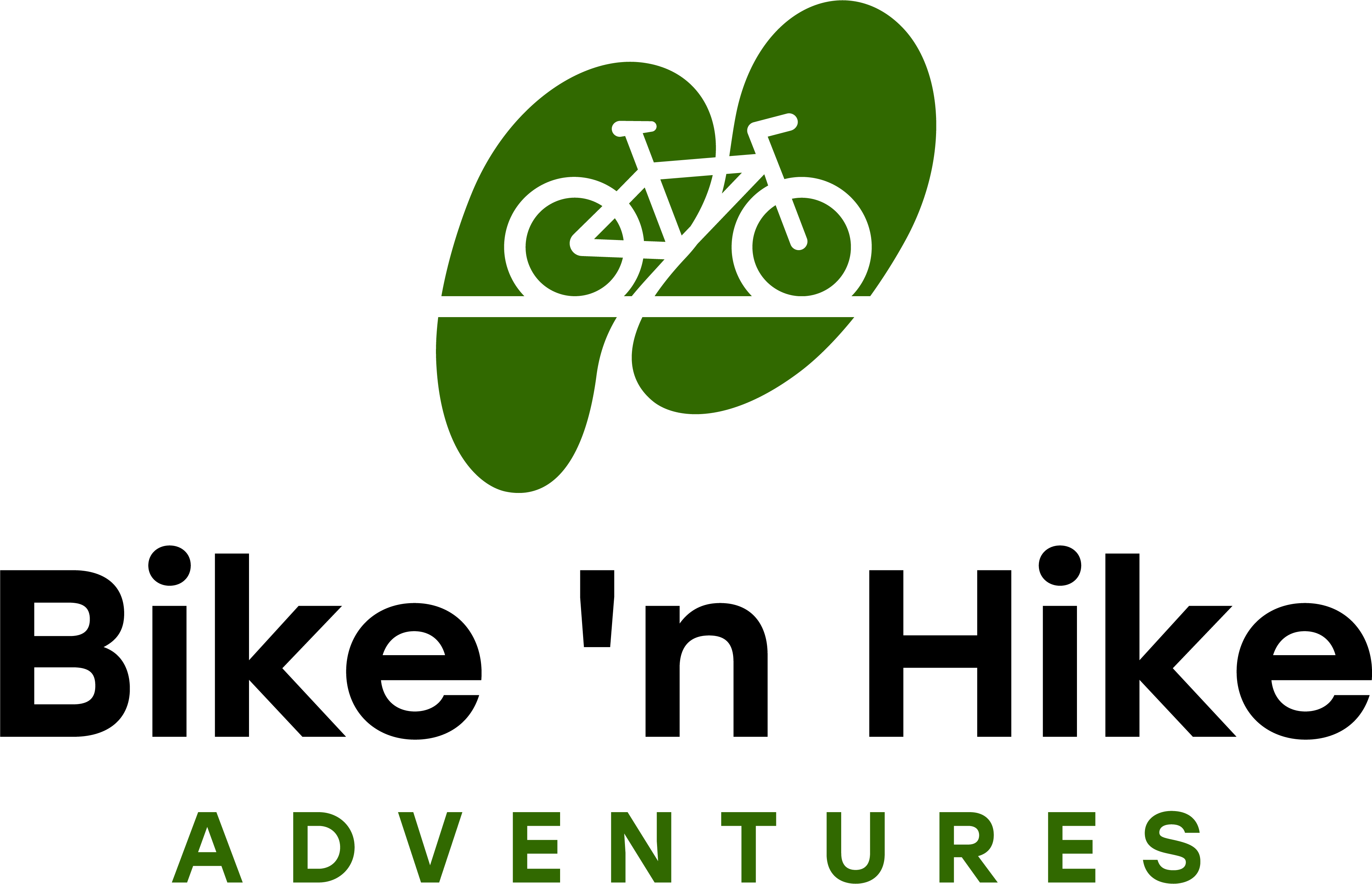Cycling Lake Constance
I had the good fortune to cycle Lake Constance in 2024 with one of my clubs.
Where is Lake Constance?
Bordered by three countries (Switzerland, Austria and Germany (with a view to Liechtenstein)), Lake Constance (or Bodensee in German) occupies an extremely beautiful location in central Europe. One of the largest freshwater lakes in Europe, it provided an incredibly scenic backdrop for a late summer cycle journey.

While there is a standard Lake Constance cycle route (Bodenseeradweg) that takes you directly around the lake, ours was a guided tour that took us to other charming towns and locations, allowing us to experience the area in a different way.
Heading out
We met our guides on a cloudy Monday morning, and left Zurich by bus to a stop on the Rhine River where we picked up our bikes. We were on our way, with our first jaw dropping site soon after, Shaffhausen, home to the Rhine Falls, the most spectacular (and powerful) waterfall in Europe. Coming from the Niagara region, we all know the majesty of Niagara Falls. The Rhine Falls were impressive in a different way. What I appreciated was the natural environment – missing were endless tourist shops selling souvenirs and fast food.
We had a far-too-quick visit to Stein am Rhein, a magical city with beautifully decorated buildings. Unfortunately the clouds were too threatening and we needed to continue to our destination, Gottlieben, staying at a very charming 17th century lake-front hotel with each room unique. We all got quite wet on the way home, just another anecdote when reminiscing about the great day we all shared.
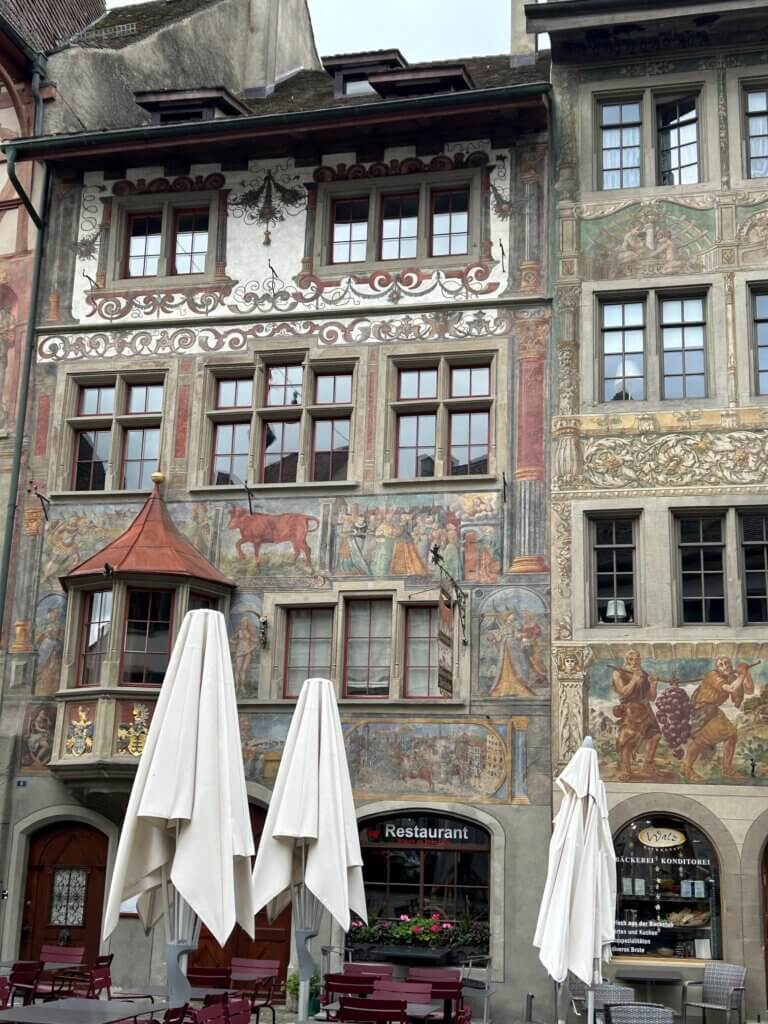
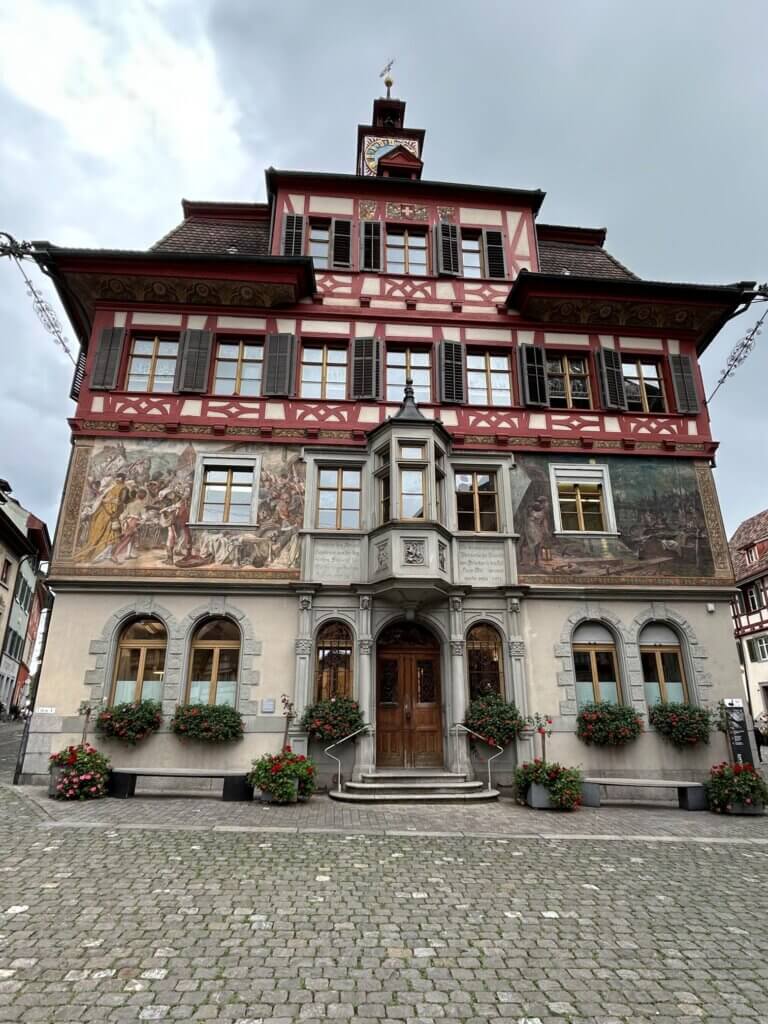

Visiting Reichenau, Konstanz, Überlingen
The next day we headed by ferry to the centre of the lake, to the Island of Reichenau (meaning “rich pasture”). Reichenau is a UNESCO World Heritage centre, once famous for being a monastery, and still well known for its rich agricultural lands. We visited the grounds of the monastery dating from 900’s, but were unable to enter as there was a service in progress. Another church on the island dates from the 700’s and has had no changes since 1048. What history! It was such a lovely island to cycle through, the local people really did their part to maintain beautiful gardens.
We continued into Germany to the city of Konstanz in time for lunch and for a tour. It has a wonderful medieval district with well maintained buildings, many of them named. I learned the history of the term “stone rich”, which meant that the owners could actually afford stone for their homes. Others had to settle for plaster in between beams, which offered up some fire protection. Lots of charming fountains in Konstanz.
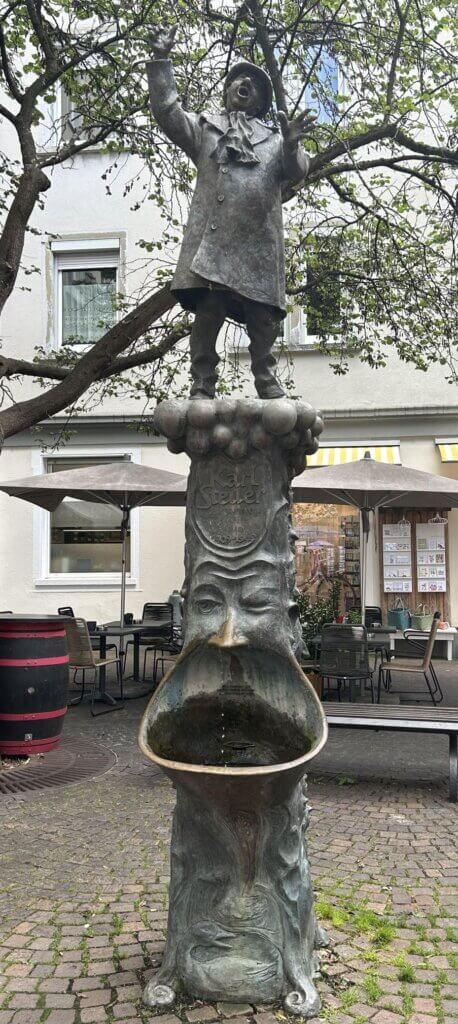

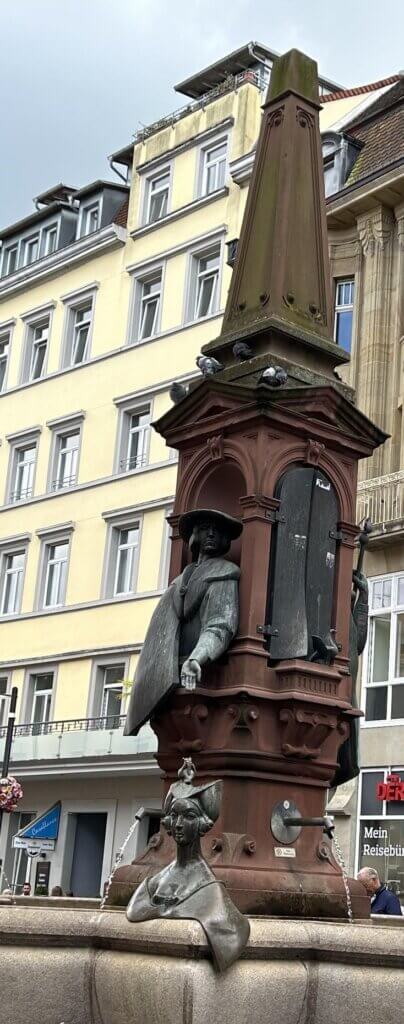
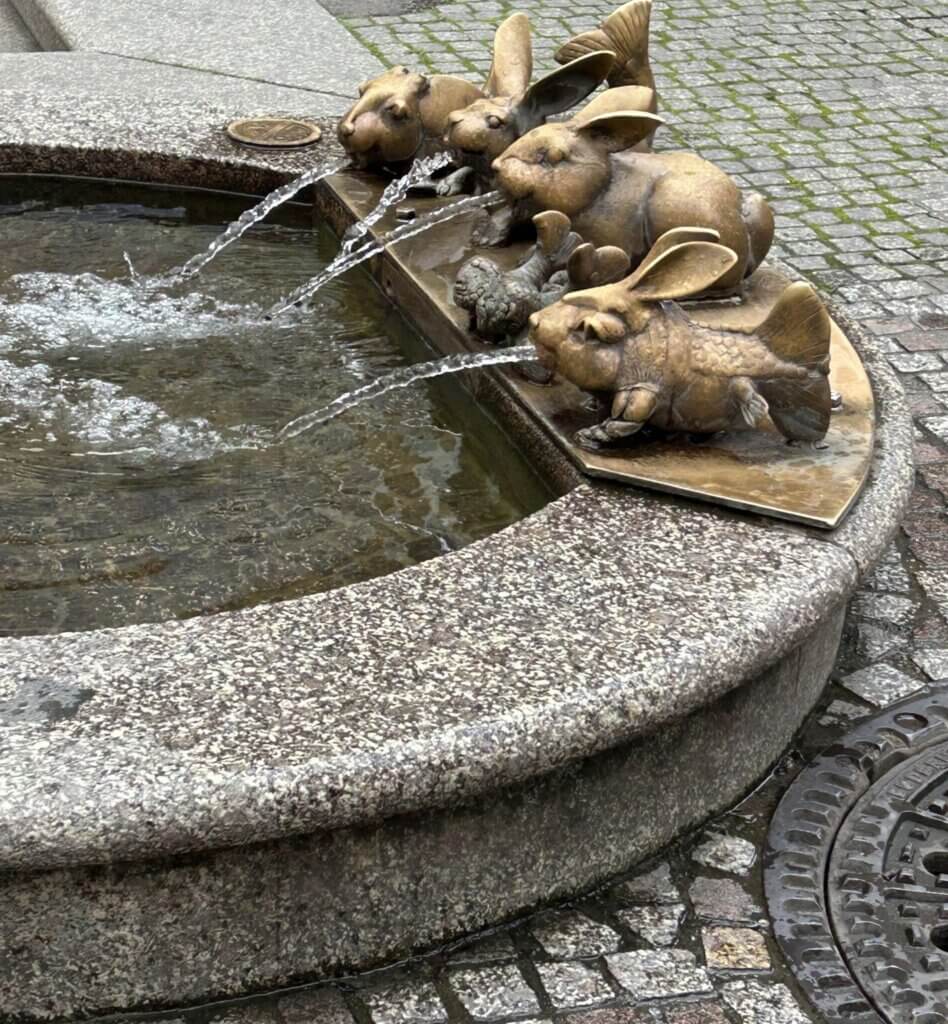
Not all the interesting things in Konstanze are hundreds of years old.
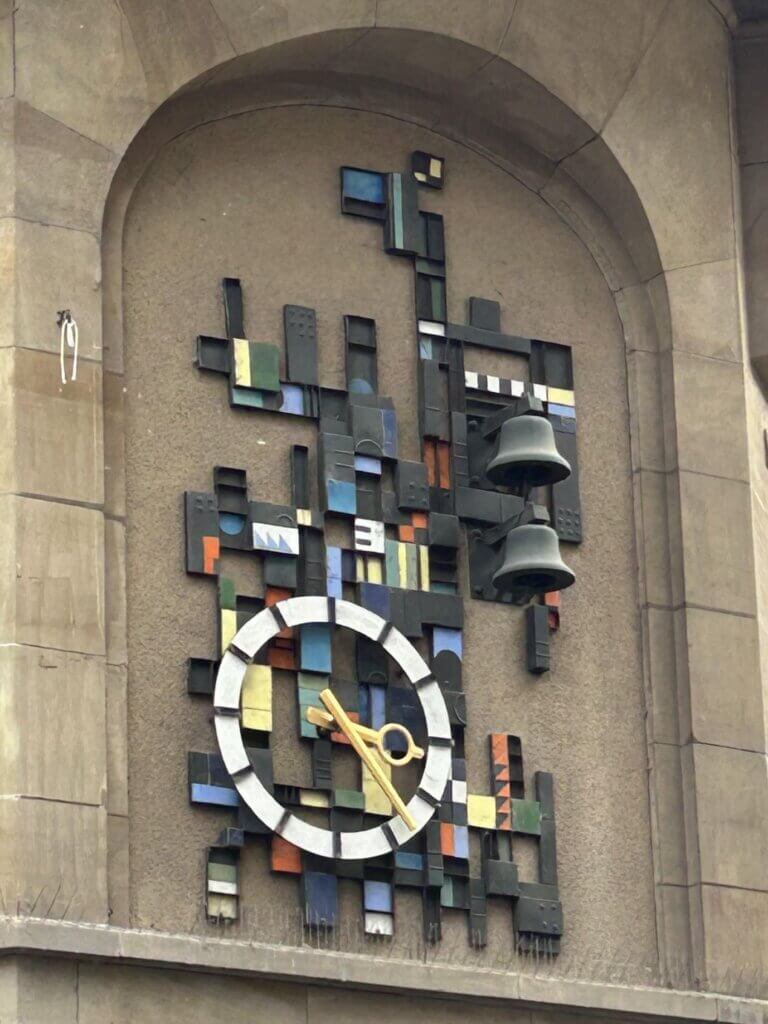
After lunch we rode on to Überlingen, where the local climate supports palm trees, almost unheard of in snow countries.
On to Meersburg and Salem
The next day we were doing a loop, discovering some small towns and admiring the landscape surrounding Überlingen. We stopped to see the Basilika Birnau with its rich and elaborate interior, full of breathtaking paintings. You could visit this basilica many times and each time see something different. It is considered a jewel of the Baroque era. An absolutely stunning church in an incredibly beautiful setting on the lake. Each one of us felt so fortunate to have seen it.
We continued cycling to Meersburg, to view the oldest inhabited castle in Germany, which unfortunately we didn’t have time to visit. We had a nice lunch there though! We wandered the old town for a bit admiring the tiny alleys and charming squares. So much to see, so little time. We had to continue, now on to Salem.
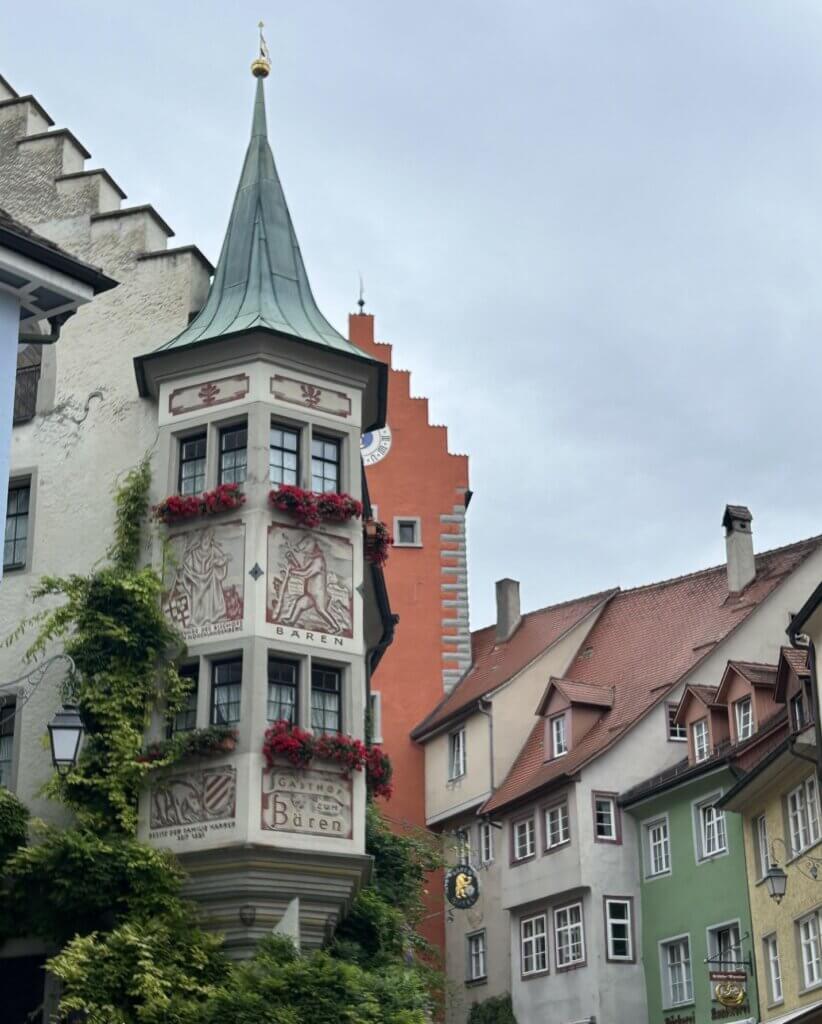

Salem is the home of another monastery, dating from 1134, now a private boarding school. We were treated to a tour of the extensive grounds and magnificent historical buildings. An unexpected delight in the monastery was the Fire Brigade Museum, which has its origins in a devastating fire in 1697. At the time, the monks decided to research fire prevention and fire-fighting equipment. Appreciation for new fire fighting technology has continued since then.

Lindau
The next day we started near Markdorf, with its amazing scenery, full of vineyards and orchards. We cycled past quaint villages and idyllic countryside, stopping for lunch at a very charming restaurant on the Deegersee Lake. Too cold for a swim today – but a beautiful setting. We had a quick stop in Wasserburg, taking the time to admire the Church of St. George, from 1396. This evening’s destination was Lindau, a town that included a smaller island “old town” with a large car-free area, where we were staying. Lindau is known for its harbour entrance with a Bavarian lion and a white lighthouse, considered the most beautiful harbour entrance on the whole of Lake Constance. The original lighthouse from 1200 hosts fairy tale sessions for kids, and has recently started offering them to adults too. How fun! On a walking tour we passed one church that now serves as a theatre, and visited St. Peter’s Church (from 1000), which has frescos dating from the 15th century.
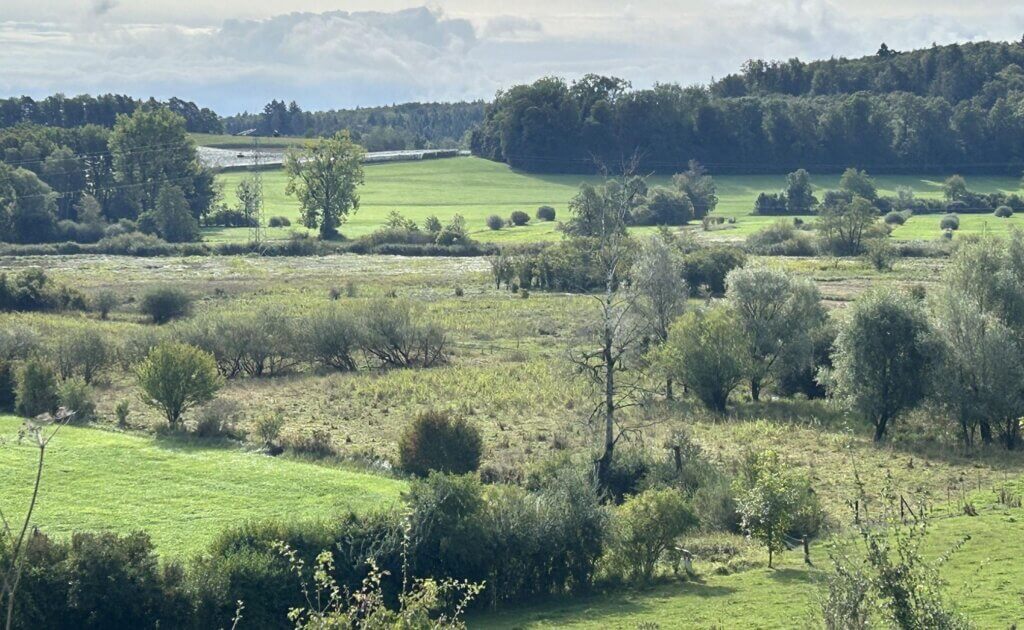

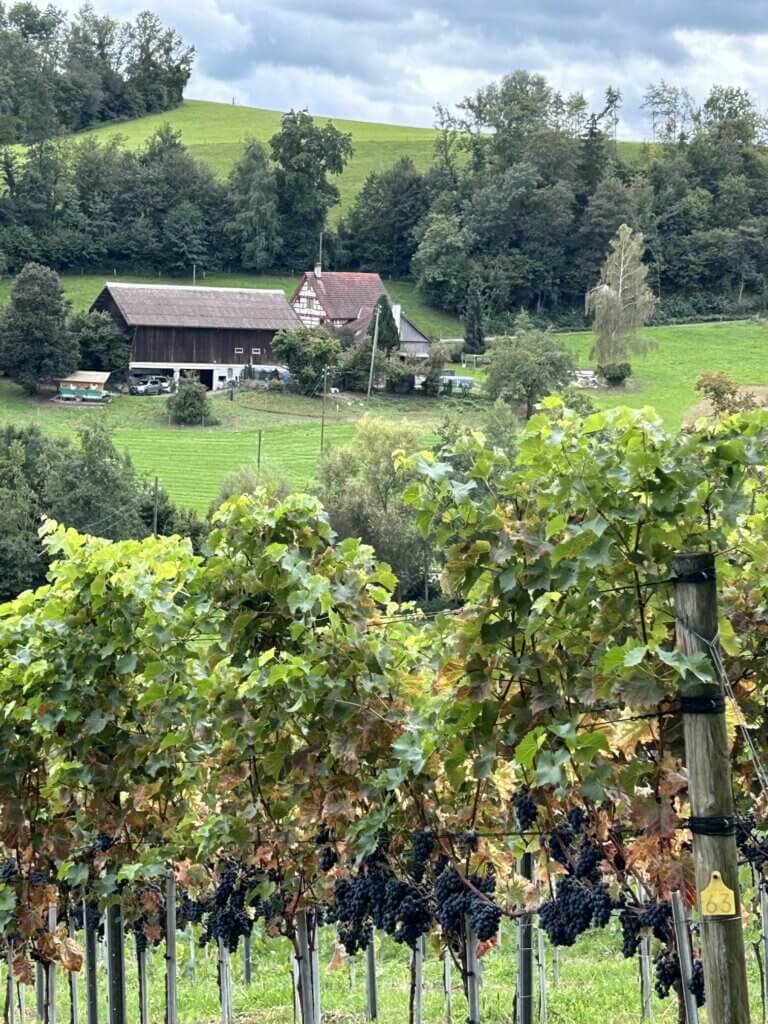
Our journey continued with a bike ride through Austria, on our way back to Switzerland and the town of St. Gallen. A 90-minute walking tour had been planned for us, consisting of a monastery and a library. My initial reaction was – so much time for only 2 things?! Both are now UNESCO World Heritage sites and definitely worth visiting. The library in St. Gallen was magnificent and considered one of the most beautiful library interiors in the world. The original library dates back to 612, when monks would come to copy manuscripts. Over 400 manuscripts from the 9th century have been preserved. One fun fact – it is the best source for food and beverage information from 1,000’s – one of the monks wrote in detail about things that were growing in the area. A key component of the library is the huge (2.3 metres high) globe built in the late 16th century. This globe is unique because it shows both the earth and the stars on the same surface. It also shows what was known in 1571 – for example – there is no Australia and very little for North America. What you see in the library is a replica, apparently much finer than the original which is all black after 500 years of use. A fascinating place to visit, and so much more fun when doing it with your cycle buddies.
We finished our riding that day, heading back to Gottlieben for the night, admiring the serene beauty of the Swiss landscape for the last time.
Where else can I ride my bike?
Three highlights:
- All the buildings with exterior paintings and frescos – so different from the usual graffiti we see in North America.
- The incredible landscapes – vineyard, orchards, cows with their symphonic bells, mountains, water – Switzerland, Germany and Austria have so much to offer.
- The library at St. Gallen – such a unique and special place to visit
Three things for next time:
- Visit Liechtenstein – another country – so close to where we are but time did not permit.
- Spend more time in the small charming towns such as Stein am Rheine, Wasserburg and Unteruhldingen in order to see more of the sites, such as the Pile Dwelling Open Air Museum, another UNESCO World Heritage Site comprising recreations of structures from the Neolithic and Bronze Age (4000 – 850 BCE), based on extensive archeological evidence.
- Attend a concert in the Basilika Birnau – I am sure it will be magical.
Please contact me if you are interested in discovering wonderful places with a new travel community!
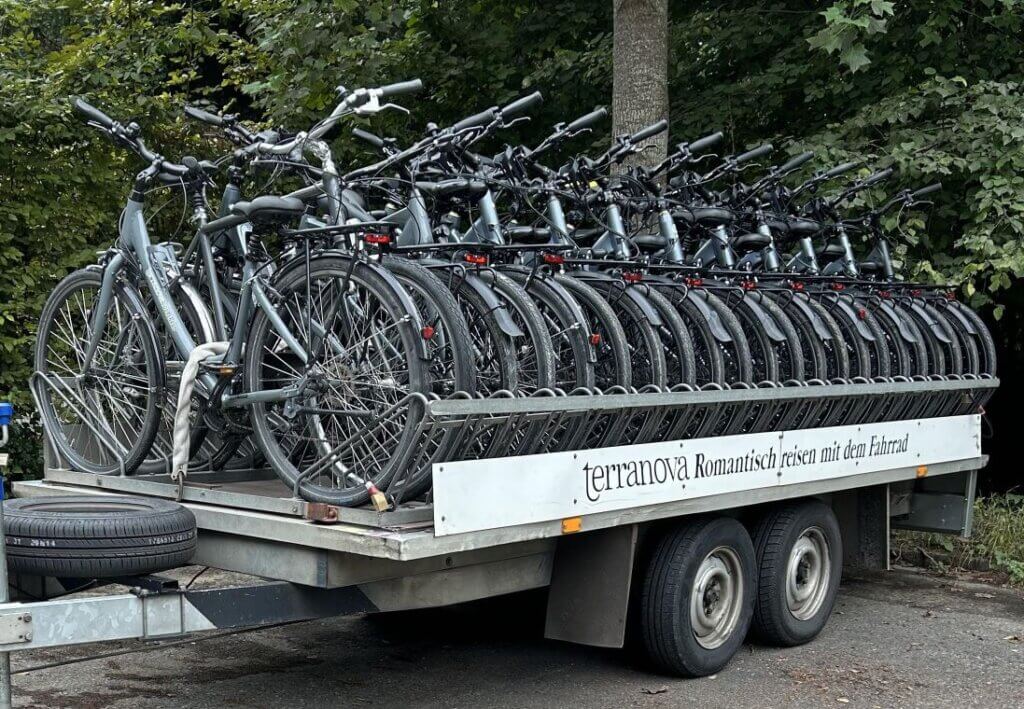
Recent Posts
Cycling Thailand
Cycling in Vietnam
Cycling in Holland
All Categories
Tags
Cycling Lake Constance
I had the good fortune to cycle Lake Constance in 2024 with one of my clubs.
Where is Lake Constance?
Bordered by three countries (Switzerland, Austria and Germany (with a view to Liechtenstein)), Lake Constance (or Bodensee in German) occupies an extremely beautiful location in central Europe. One of the largest freshwater lakes in Europe, it provided an incredibly scenic backdrop for a late summer cycle journey.

While there is a standard Lake Constance cycle route (Bodenseeradweg) that takes you directly around the lake, ours was a guided tour that took us to other charming towns and locations, allowing us to experience the area in a different way.
Heading out
We met our guides on a cloudy Monday morning, and left Zurich by bus to a stop on the Rhine River where we picked up our bikes. We were on our way, with our first jaw dropping site soon after, Shaffhausen, home to the Rhine Falls, the most spectacular (and powerful) waterfall in Europe. Coming from the Niagara region, we all know the majesty of Niagara Falls. The Rhine Falls were impressive in a different way. What I appreciated was the natural environment – missing were endless tourist shops selling souvenirs and fast food.
We had a far-too-quick visit to Stein am Rhein, a magical city with beautifully decorated buildings. Unfortunately the clouds were too threatening and we needed to continue to our destination, Gottlieben, staying at a very charming 17th century lake-front hotel with each room unique. We all got quite wet on the way home, just another anecdote when reminiscing about the great day we all shared.



Visiting Reichenau, Konstanz, Überlingen
The next day we headed by ferry to the centre of the lake, to the Island of Reichenau (meaning “rich pasture”). Reichenau is a UNESCO World Heritage centre, once famous for being a monastery, and still well known for its rich agricultural lands. We visited the grounds of the monastery dating from 900’s, but were unable to enter as there was a service in progress. Another church on the island dates from the 700’s and has had no changes since 1048. What history! It was such a lovely island to cycle through, the local people really did their part to maintain beautiful gardens.
We continued into Germany to the city of Konstanz in time for lunch and for a tour. It has a wonderful medieval district with well maintained buildings, many of them named. I learned the history of the term “stone rich”, which meant that the owners could actually afford stone for their homes. Others had to settle for plaster in between beams, which offered up some fire protection. Lots of charming fountains in Konstanz.




Not all the interesting things in Konstanze are hundreds of years old.

After lunch we rode on to Überlingen, where the local climate supports palm trees, almost unheard of in snow countries.
On to Meersburg and Salem
The next day we were doing a loop, discovering some small towns and admiring the landscape surrounding Überlingen. We stopped to see the Basilika Birnau with its rich and elaborate interior, full of breathtaking paintings. You could visit this basilica many times and each time see something different. It is considered a jewel of the Baroque era. An absolutely stunning church in an incredibly beautiful setting on the lake. Each one of us felt so fortunate to have seen it.
We continued cycling to Meersburg, to view the oldest inhabited castle in Germany, which unfortunately we didn’t have time to visit. We had a nice lunch there though! We wandered the old town for a bit admiring the tiny alleys and charming squares. So much to see, so little time. We had to continue, now on to Salem.


Salem is the home of another monastery, dating from 1134, now a private boarding school. We were treated to a tour of the extensive grounds and magnificent historical buildings. An unexpected delight in the monastery was the Fire Brigade Museum, which has its origins in a devastating fire in 1697. At the time, the monks decided to research fire prevention and fire-fighting equipment. Appreciation for new fire fighting technology has continued since then.

Lindau
The next day we started near Markdorf, with its amazing scenery, full of vineyards and orchards. We cycled past quaint villages and idyllic countryside, stopping for lunch at a very charming restaurant on the Deegersee Lake. Too cold for a swim today – but a beautiful setting. We had a quick stop in Wasserburg, taking the time to admire the Church of St. George, from 1396. This evening’s destination was Lindau, a town that included a smaller island “old town” with a large car-free area, where we were staying. Lindau is known for its harbour entrance with a Bavarian lion and a white lighthouse, considered the most beautiful harbour entrance on the whole of Lake Constance. The original lighthouse from 1200 hosts fairy tale sessions for kids, and has recently started offering them to adults too. How fun! On a walking tour we passed one church that now serves as a theatre, and visited St. Peter’s Church (from 1000), which has frescos dating from the 15th century.



Our journey continued with a bike ride through Austria, on our way back to Switzerland and the town of St. Gallen. A 90-minute walking tour had been planned for us, consisting of a monastery and a library. My initial reaction was – so much time for only 2 things?! Both are now UNESCO World Heritage sites and definitely worth visiting. The library in St. Gallen was magnificent and considered one of the most beautiful library interiors in the world. The original library dates back to 612, when monks would come to copy manuscripts. Over 400 manuscripts from the 9th century have been preserved. One fun fact – it is the best source for food and beverage information from 1,000’s – one of the monks wrote in detail about things that were growing in the area. A key component of the library is the huge (2.3 metres high) globe built in the late 16th century. This globe is unique because it shows both the earth and the stars on the same surface. It also shows what was known in 1571 – for example – there is no Australia and very little for North America. What you see in the library is a replica, apparently much finer than the original which is all black after 500 years of use. A fascinating place to visit, and so much more fun when doing it with your cycle buddies.
We finished our riding that day, heading back to Gottlieben for the night, admiring the serene beauty of the Swiss landscape for the last time.
Where else can I ride my bike?
Three highlights:
- All the buildings with exterior paintings and frescos – so different from the usual graffiti we see in North America.
- The incredible landscapes – vineyard, orchards, cows with their symphonic bells, mountains, water – Switzerland, Germany and Austria have so much to offer.
- The library at St. Gallen – such a unique and special place to visit
Three things for next time:
- Visit Liechtenstein – another country – so close to where we are but time did not permit.
- Spend more time in the small charming towns such as Stein am Rheine, Wasserburg and Unteruhldingen in order to see more of the sites, such as the Pile Dwelling Open Air Museum, another UNESCO World Heritage Site comprising recreations of structures from the Neolithic and Bronze Age (4000 – 850 BCE), based on extensive archeological evidence.
- Attend a concert in the Basilika Birnau – I am sure it will be magical.
Please contact me if you are interested in discovering wonderful places with a new travel community!

